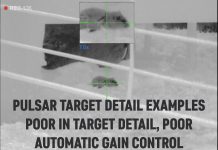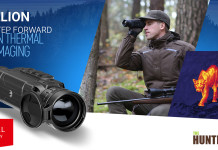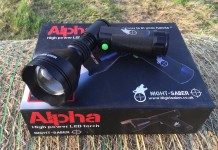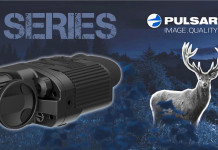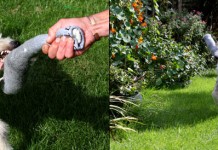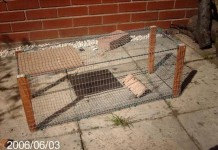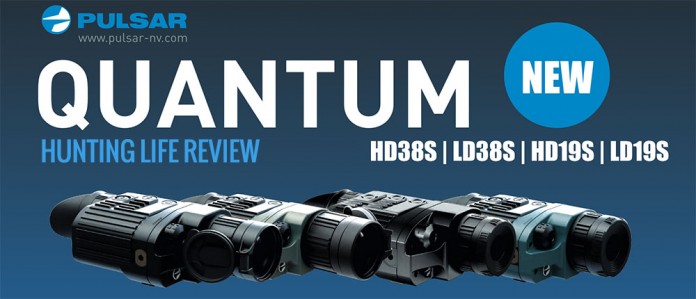This is a hands on review of the Pulsar HD38S thermal imager, this new release from Pulsar is top end technology which aids pest controllers, shooters, fox shooters and deer stalkers. The unit itself is very compact compared to alternative thermal imagers available, making it ideal to slip into a jacket pocket and light to use, it utilises four AA batteries which power the unit via a plastic battery holder, two of these holders are supplied with the unit, along with a robust carry case, cleaning cloth and video out cable, the supplied battery cell’s are quality Ansmann batteries complete with charger, as supplied with the N750A night vision units.
The units body is made up of a rubberised armoured exterior, which houses an external power supply and video out connection underneath, also a weaver rail adaptor and female 1/3″ tripod mounts either side, it also features three control button on the top of the unit, one of these powers the unit up, one manually calibrates the unit to its surroundings, the third changes to 2x digital zoom making it a 4x device, very slight image degradation is noticed as with all digital zoom when used, but the feature is very useful for picking up distance heat sources particularly rabbits, which are sometimes easier to pickup utilising this, this same button also when kept pressed in for a second changes the heat signature from white hot to black hot, the advantage of this being, depending on the terrain it can stand out more clearer and give a little more detail, but the white can be much easier to pickup the inital heat source. The last button is at the front of the unit and this rotary button adjusts brightness by rotating, press it in briefly and it switches to contrast adjustment, if you keep it pressed in for two seconds it enters the menu mode, which is visible from the eyepiece.
The menu gives you a selection of various options, including changing the operationg modes from city, forest and identification, these are basically preset option of the contrast and brightness settings which can be selected to enhance viewing, most users will adjust these dependant on your eye sight and preference. Tne calibration can also be changed from auto, semi-auto and manual calibration, the device is preset to auto calibrate, but in certain situations a manual calibrate might be handy, as the device pauses for a second when it calibrates, which could be a crucial second if a target is moving when tracking in auto calibrate mode. The menu also includes defective pixel repair option and menu icon brightness adjustment.
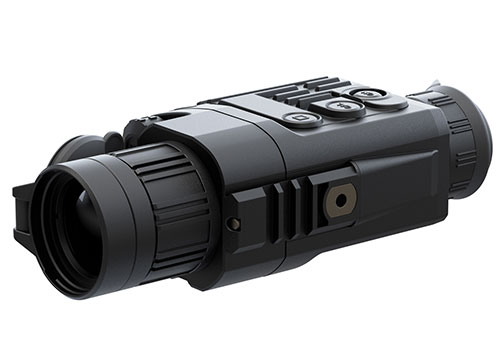
Now we have covered the main features and design of the unit let’s get into its use in the field.
Using the Pulsar HD38S during night time, its amazing what you really see active , no more lamp shy game or foxes, there’s been situations when a field is lamped for a rabbit or fox and with the slightest glimpse of a light even from another field away they are off, using thermal, its surprising how many things you see and in numbers that you didn’t realise were actually there, the fact thermal is totally covert and uses no additional light or IR source makes it very effective.
Rabbits and foxes sat in hedges and open grass are easily spotted along with birds, hedgehogs, deer, the ability to instantly pickup a heat source from a great distance and with the animals back to you makes thermal as a spotting device perfect, unlike night vision which sometimes requires additonal IR to detect and look for eyeshine.
The ability if out solo, not having to carry a large lamping setup is a massive plus point, areas can be ambushed from different angles dependent on animal location and wind direction, without any disturbance of the quarry at all.
When shooting rabbits and foxes, they can be shot and left and you an carry out around the farm, on returning or backtracking your steps, its easy to locate and pickup your quarry hours later through its residual heat signature, this is especially useful again when out single handed and shooting larger bags of game, also I’m sure we have lost many a rabbit or fox in grass and stubble when they just seem to blend in when looking with torch light sometimes, with thermal imaging, this is a thing of the past.
Whilst out using the unit for ratting, in tandem with night vision, rats hid under tin sheeting, distant hedges and peeking through bales are instantly spotted, aiding you to point out to a shooting partner with lamp or nightvision were there actually hidden in some surroundings they blend into.
Battery life of the HD38S using supplied 2800mah batteries averages 6- 7hrs with the unit constantly on, which is an excellent runtime and provides a full nights hunting. The unit takes around 8 seconds to power up from off, but once turned on, the unit is left on constantly all night, and its available to view and scan fields and terrain instantly.
Overall the Pulsar HD38S is an excellent tool, with similar if not better image quality than similar thermal imagers costing £1000+ more. If you are an avid shooter, night hunter or deer stalker the new generation of thermal imagers are excellent for picking up quarry at a great distance day or night, in cover and hedges were night vision would be limited and most of all they are totally covert.
Even though the unit is excellent, nothing in life is truly perfect. Image quality and size of the unit is great, but here’s some suggestions from using the unit in the field that would make it even better, take note Pulsar!
Room for improvement
Eye piece shut off – When using the unit its far easier to be left powered up, rather than turning it on and off, the downside of this is the light emitted from the eyepiece, can alert quarry close range, but can be covered with another hand. If it was possible to have a button to leave the unit powered up BUT turn the eyepiece display off this would be an excellent improvement and feature, that could be easily implemented, alternatively a shuttered eye piece would also be beneficial.
Brightness/contrast adjustment – Is very easily moved on a regular basis when using the unit and its stored in a pocket or its case its easy to adjust the brightness contrast rotary knob, this controls a lot of the functions on the Pulsar HD38S also, but if it was spring loaded and had the ability to be locked in position, this would be another massive improvement.
Battery holder confusing, difficult to replace batteries – The position of the battery holder cases, positive and negative indications are correct, although the actual terminal layouts seem to be back to front, confusing some users, if they don’t view the engraved indication, also when batteries are fitted into holder they are difficult to remove and sometimes require a small screwdriver to prise out.
Built in recording function – The ability to record straight to memory card built into the Pulsar HD38S would be great and prevent having to carry additional DVR accessories, similar to the Guide thermal imager setup.
These small improvements would make the already great HD38S head above the competition even more in its relative price range.
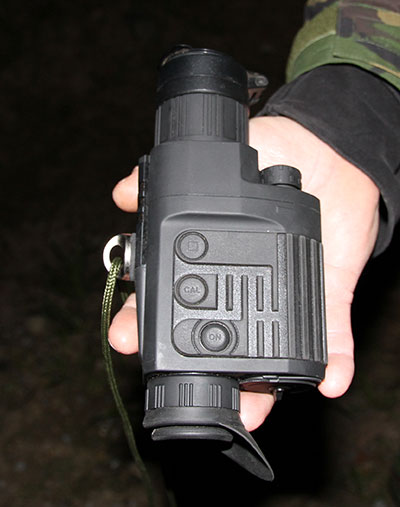
Other findings from using the Pulsar HD38S in the field.
Display icons can reflect in eyepiece during daytime use – When using the unit in daytime, the blue icons can actually reflect back into your eyepiece view on the screen, Pulsar has already a solution in place in the unit to deal with this, in the menu setting there is an option to reduce the brightness of the icons from a scale of 1-10 to prevent this… Good thinking on Pulsars side..
Finally another point noted that affects all thermal device. When in use, they will pickup heat signatures from a great distance, also giving you a view of surrounding terrain, land and trees with great clarity. When the air is misty, foggy and holds a high water content heat is still picked up by the unit, although the terrain layout image of surroundings suffers badly and contrast suffers, i.e hedges and trees are very difficult to view, although the radiant heat signals are still visible.


